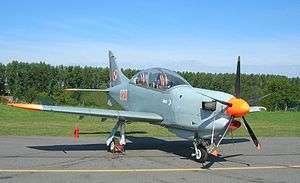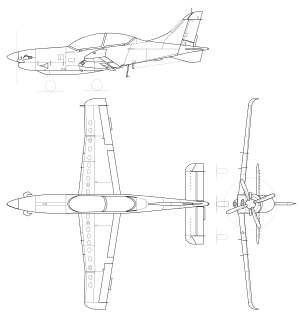PZL-130 Orlik
| PZL-130 Orlik | |
|---|---|
 | |
| Role | trainer |
| National origin | Poland |
| Manufacturer | PZL Warszawa-Okecie |
| First flight | 24 October 1984 |
| Introduction | 1994 |
| Primary user | Polish Air Force |
| Number built | 50 + 9 prototypes |
|
| |
The PZL 130 Orlik (English: Eaglet) is a Polish turboprop, single engine, two seat trainer.
Development and design
The Orlik was designed by PZL Warszawa-Okecie as a trainer for the Polish Air Force, intended as a replacement for its PZL-110 Kolibers. It was also designed to meet the American FAR 23 standard. The project was under the supervision of Andrzej Frydrychewicz, head engineer of PZL Warszawa-Okecie. It was fitted with a low-aspect ratio wing to better simulate the handling characteristics of jet fighters.[1] The aircraft was designed to be powered by a Soviet-designed and built Vedeneyev M14Pm radial engine with the intention of replacing it by a modified Polish built Ivchenko AI-14 engine in production aircraft.[2] The first prototype Orlik flew on 12 October 1984, with a second prototype following in December and a third in January 1985.[2]
While the Polish Air Force planned to power its Orliks with locally produced radial engines, PZL planned a turboprop powered version, the PZL-130T Turbo Orlik for export purposes.[3] The third prototype was therefore re-fitted with a 410 kW (550 shp) Pratt & Whitney PT6A-25P turboprop, flying in this form on 13 July 1986, but was destroyed in a crash in January 1987 while being demonstrated to a representative of the Colombian Air Force.[4] Two further turboprop prototypes followed in 1989 and 1990, powered by a Czech-built 560 kW (750 shp) Walter M-601E and a PT6A-25 as the PZL-130TB and PZL-130TP respectively.[5]
In 1990, development of the piston-engined Orlik was abandoned, as the Polish built radial engines gave insufficient power, with Polish interest switching to the M-601 powered PZL-130TB.[5]
Operational history
Deliveries of PZL-130TBs to Poland started in 1994, with the aircraft equipping the Military Pilot Academy at Dęblin and the 60th Training Air Regiment at Radom. All Polish PZL-130TBs were upgraded to the TC-1 standard type, with better ejection seats and avionics.[6]
Variants
.jpg)
.jpg)
- PZL-130 Orlik
- The original aircraft with one Vedeneyev M14Pm piston engine
- PZL-130T Turbo Orlik
- Variant with a Pratt & Whitney Canada PT6A-25P turboprop engine
- PZL-130TM Orlik
- Variant with a Walter M601E turboprop engine
- PZL-130TB Orlik
- Variant with a Walter M601T turboprop engine
- PZL-130TC I Orlik
- Variant with added Martin-Baker Mk.11, zero-zero class ejection seats and modernized avionics
- PZL-130TC II Orlik (Garmin)
- Variant with Pratt & Whitney Canada PT6A-25C turboprop, added winglets, modernized Garmin avionics and changed flight tutor's seat position[7]
- PZL-130TC II Orlik (GC)
- Variant with glass cockpit and Head-Up Display, company name is Orlik MPT (Multi Purpose Trainer).[8]
Operators
- Polish Air Force
- Polish Navy – Former operator.
Specifications (PZL-130TC II Orlik)

General characteristics
- Crew: 2
- Length: 9.3 m (30 ft 6 in)
- Wingspan: 10 m (32 ft 10 in)
- Height: 3.53 m (11 ft 7 in)
- Wing area: 14.56 m2 (156.7 sq ft)
- Empty weight: 1,825 kg (4,023 lb)
- Gross weight: 2,400 kg (5,291 lb)
- Max takeoff weight: 2,950 kg (6,504 lb)
- Powerplant: 1 × Pratt & Whitney Canada PT6A-25C turboprop, 560 kW (750 shp)
Performance
- Maximum speed: 550 km/h (342 mph; 297 kn)
- Cruising speed: 490 km/h (304 mph; 265 kn)
- Range: 2,200 km (1,367 mi; 1,188 nmi)
- Service ceiling: 10,000 m (32,808 ft)
- Rate of climb: 14.4 m/s (2,830 ft/min)
Armament
- Hardpoints: 6 with a capacity of 700 kg (1,500 lb),
See also
- Aircraft of comparable role, configuration and era
- Atlas ACE
- Beechcraft T-6 Texan II
- Beechcraft T-34 Mentor
- Embraer EMB 312 Tucano
- Fuji T-7
- KAI KT-1
- Pilatus PC-7
- Pilatus PC-9
- Pilatus PC-21
- Short Tucano
- Socata TB-31 Omega
- TAI Hürkuş
- Kobac
Notes
References
- Lambert, Mark. Jane's All The World's Aircraft 1993–94. Coulsdon, UK:Jane's Data Division, 1993. ISBN 0-7106-1066-1.
- "Orlik…A Polish Fledgeling". Air International, October 1985, Vol 29 No 4. pp. 167–172. ISSN 0306-5634.
- Taylor, John W. R. Jane's All The World's Aircraft 1988–89. Coulsdon, UK:Jane's Defence Data, 1988. ISBN 0-7106-0867-5.
- Taylor, Michael J.H. Brassey's World Aircraft & Systems Directory 1999/2000. London: Brassey's, 1999. ISBN 1-85753-245-7.
External links
| Wikimedia Commons has media related to PZL-130 Orlik. |